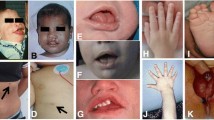Abstract
17q11 microdeletions that encompass NF1 cause 5%–10% of cases of neurofibromatosis type 1, and individuals with microdeletions are typically taller than individuals with intragenic NF1 mutations, suggesting that deletion of a neighboring gene might promote human growth. We identified mutations in RNF135, which is within the NF1 microdeletion region, in six families characterized by overgrowth, learning disability, dysmorphic features and variable additional features. These data identify RNF135 as causative of a new overgrowth syndrome and demonstrate that RNF135 haploinsufficiency contributes to the phenotype of NF1 microdeletion cases.

Similar content being viewed by others
References
Ferner, R.E. et al. J. Med. Genet. 44, 81–88 (2007).
Messiaen, L.M. et al. Hum. Mutat. 15, 541–555 (2000).
Kluwe, L. et al. Hum. Mutat. 23, 111–116 (2004).
De Raedt, T. et al. Nat. Genet. 38, 1419–1423 (2006).
Tonsgard, J.H. et al. Am. J. Med. Genet. 73, 80–86 (1997).
Spiegel, M. et al. Eur. J. Hum. Genet. 13, 883–888 (2005).
Devriendt, K. & Vermeesch, J.R. Hum. Genomics 1, 126–133 (2004).
Butler, M.G. et al. J. Med. Genet. 42, 318–321 (2005).
Joazeiro, C.A.P. & Weissman, A.M. Cell 102, 549–552 (2000).
Rhodes, D.A. et al. Immunology 116, 411–417 (2005).
Quaderi, N.A. et al. Nat. Genet. 17, 285–291 (1997).
Venturin, M. et al. J. Med. Genet. 41, 35–31 (2004).
De Raedt, T. et al. Am. J. Hum. Genet. 72, 1288–1292 (2003).
Cohen, M., Neri, G. & Weksberg, R. Overgrowth Syndromes (Oxford Univ. Press, New York, 2002).
Van Asperen, C.J. et al. J. Med. Genet. 35, 323–327 (1998).
Acknowledgements
We thank the participating families who were recruited to the study by the Childhood Overgrowth Collaboration, which includes the following contributors: M. Addor, A. Al Swaid, J. Amiel, S. Andries, H. Archer, A. Barnicoat, M. Barrow, J. Barwell, G. Baujat, K. Becker, J. Berg, B. Bernhard, M. Bhat, M. Bitner, E. Blair, A. Brady, L. Brueton, S. Cavani, M. Cecconi, K. Chandler, C. Christensen, A. Clarke, J. Clayton-Smith, T. Cole, L. Colleaux, A. Colley, A. Collins, V. Cormier-Daire, S. Danda, S. Davies, R. Day, D.R. Magali, N. Dennis, A. Dobbie, P. Edery, F. Elmslie, F. Faravelli, H. Firth, R. Fischetto, D. FitzPatrick, F. Forzano, N. Foulds, J. Franklin, A. Fryer, S. Garcia, C. Gardiner, C. Garrett, B. Gener, R. Gibbons, Y. Gillerot, G. Gillessen-Kaesbach, D. Goudie, M. Grasso, A. Henderson, J. Hirst, S. Hodgson, S. Holder, T. Homfrey, H. Hughes, B. Kerr, A. Kumar, D. Kumar, D. Lacombe, W. Lam, M. Le Merrer, N. Leonard, J. Liebelt, P. Lunt, S. Lynch, S. Lyonnet, A. Magee, M. Malacarne, S. Mansour, M. McEntagart, S. Majore, S. McKee, C. McKeown, P. Meinecke, K. Metcalfe, D. Milani, S. Mohammad, A. Munnich, A. Murray, A. Nemeth, G. Neri, S. Odent, S. Park, M. Patton, E. Penny, D. Pilz, B. Plecko, C. Pollitt, S. Price, O. Quarrell, A. Raas-Rothschild, N. Rahman, W. Raith, J. Rankin, L. Raymond, W. Reardon, E. Reid, E. Rosser, D. Ruddy, A. Saggar-Malik, H. Santos, G. Scarano, G.B. Schaeffer, A. Schulze, A. Selicorni, A. Shaw, M. Silengo, S. Smithson, M. Splitt, F. Stewart, H. Stewart, M. Suri, E. Sweeney, K. Tatton-Brown, I.K. Temple, E. Thompson, M. Tischkowitz, J. Tolmie, S. Turkmen, P. Turnpenny, L. Van Maldergem, P. Vasudevan, I. Vaz, D. Waggoner, C. Verellen, G. Viot, E. Wakeling, D. Weaver, K. White, L. Wilson, P. Zack, G. Zampino, A. Zankl. We are grateful to S. Huson and L. Side for providing photographs of individuals with NF1 microdeletions. We are very grateful to J. Shipley and A. Mcintyre for providing DNA from Chinese individuals without overgrowth. The research was supported by the Child Growth Foundation, the Institute of Cancer Research and the Medical Research Council (UK).
Author information
Authors and Affiliations
Contributions
J.D., D.C. and K.C. undertook the mutation screening and MLPA analysis. K.B. undertook the RNF135 expression analysis. K.T.B contributed to exclusion of known overgrowth genes. D.C., K.T.B., B.B., J.B., D.J., M.M., S.M., E.R., V.C.-D. and T.C. provided clinical information and samples from individuals with RNF135 mutations. N.R. designed the study and wrote the paper.
Corresponding author
Ethics declarations
Competing interests
The authors declare no competing financial interests.
Supplementary information
Supplementary Text and Figures
Supplementary Methods, Supplementary Tables 1–2 (PDF 45 kb)
Rights and permissions
About this article
Cite this article
Douglas, J., Cilliers, D., Coleman, K. et al. Mutations in RNF135, a gene within the NF1 microdeletion region, cause phenotypic abnormalities including overgrowth. Nat Genet 39, 963–965 (2007). https://doi.org/10.1038/ng2083
Received:
Accepted:
Published:
Issue Date:
DOI: https://doi.org/10.1038/ng2083
- Springer Nature America, Inc.
This article is cited by
-
Correlation between large rearrangements and patient phenotypes in NF1 deletion syndrome: an update and review
BMC Medical Genomics (2024)
-
Considerations on diagnosis and surveillance measures of PTEN hamartoma tumor syndrome: clinical and genetic study in a series of Spanish patients
Orphanet Journal of Rare Diseases (2022)
-
Backbone 1H, 13C, and 15N resonance assignments of the PRY-SPRY domain of RNF135
Biomolecular NMR Assignments (2019)
-
Identification of an atypical microdeletion generating the RNF135-SUZ12 chimeric gene and causing a position effect in an NF1 patient with overgrowth
Human Genetics (2017)
-
Emerging genotype–phenotype relationships in patients with large NF1 deletions
Human Genetics (2017)





